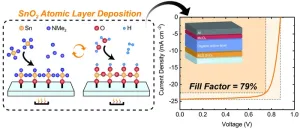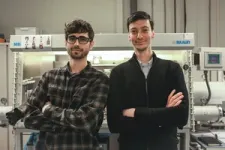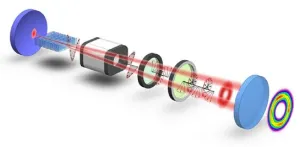(Press-News.org) Organic solar cells have a photoactive layer that is made from polymers and small molecules. The cells are very thin, can be flexible, and are easy to make. However, the efficiency of these cells is still much below that of conventional silicon-based ones. Applied physicists from the University of Groningen have now fabricated an organic solar cell with an efficiency of over 17 percent, which is in the top range for this type of material. It has the advantage of using an unusual device structure that is produced using a scalable technique. The design involves a conductive layer of tin oxide that is grown by atomic layer deposition. The scientists also have several ideas to further improve the efficiency and stability of the cell. The results have been described in the journal Advanced Materials on 31 March.
In organic solar cells, polymers and small molecules convert light into charges that are collected at the electrodes. These cells are made as thin films of different layers—each with its own properties—that are stacked onto a substrate. Most important is the photoactive layer, which converts light into charges and separates the electrons from the holes, and the transport and blocking layer, which selectively directs the electrons towards the electrode.
Stability
‘In most organic solar cells, the electron transport layer is made of zinc oxide, a highly transparent and conductive material that lays below the active layer,’ says David Garcia Romero, a PhD student in the Photophysics and Optoelectronics group at the Zernike Institute for Advanced Materials at the University of Groningen, led by Professor Maria Antonietta Loi. Garcia Romero and Lorenzo Di Mario, a postdoctoral researcher in the same group, worked on the idea of using tin oxide as the transport layer. ‘Zinc oxide is more photoreactive than tin oxide and, therefore, the latter should lead to a higher device stability,’ he explains.
Although tin oxide had shown promising results in previous studies, the best way to grow it into a suitable transport layer for an organic solar cell had not yet been found. ‘We used atomic layer deposition, a technique that had not been used in the field of organic photovoltaics for a long time,’ says Garcia Romero. However, it has some important advantages: ‘This method can grow layers of exceptional quality and it is scalable to industrial processes, for example in roll-to-roll processing.
Scalable
The organic solar cells that were made with tin oxide deposited by atomic layer deposition on top show a very good performance. ‘We achieved a champion efficiency of 17.26 percent,’ says Garcia Romero. The fill factor, an important parameter of solar cell quality, showed values up to 79 percent, in agreement with the record values for this type of structure. Furthermore, the optical and structural characteristics of the tin oxide layer could be tuned by varying the temperature at which the material is deposited. A maximum power conversion was reached in cells with a transport layer that was deposited at 140 degrees Celsius. This same result was demonstrated for two different active layers, meaning that the tin oxide improved efficiency in a generic way.
‘Our aim was to make organic solar cells more efficient and to use methods that are scalable,’ says Garcia Romero. The efficiency is close to the current record for organic solar cells, which stands around 19 percent. ‘And we haven’t optimized the other layers yet. So, we need to push our structure a bit further.’ Garcia Romero and his co-author Lorenzo di Mario are also keen to try making larger area cells. These are typically less efficient but are needed to step towards real-world applications and panels.
Improvement
The new solar cell with an impressively high fill factor is a good starting point for further development. Garcia Romero: ‘It may be a bit early for industrial partners to take this on; we need to do some more research first. And we hope that our use of atomic layer deposition will inspire others in the field.’ ‘We always strive to understand what is happening in a material and in a device structure,’ adds Professor Loi. ‘Here, we think that there might be room for improvement. In that process, our tin oxide transport layer is a great initial step.’ This class of solar cells may make an important extra contribution to the energy transition because of their mechanical properties and their transparency. ‘We expect that they will be used in a totally different way than silicon panels,’ says Loi. ‘We need to think broader and out of the box at the moment.’
Lorenzo Di Mario, David Garcia Romero, Han Wang, Eelco K. Tekelenburg, Sander Meems, Teodor Zaharia, Giuseppe Portale en Maria A. Loi: Outstanding Fill Factor in Inverted Organic Solar Cells with SnO2 by Atomic Layer Deposition. Avanced Materials, online 31 maart 2023.
END
Outstanding performance of organic solar cell using tin oxide
2023-04-24
ELSE PRESS RELEASES FROM THIS DATE:
Redox Medicine 2023: Where is the target?
2023-04-24
The 25th International Conference on Redox Medicine will take place on June 21-23 in Paris. Redox Medicine 2023 will provide a glimpse into the role of redox in tomorrow’s medicine.
What to Expect in Redox Medicine 2023?
Reactive oxygen species (ROS) have been studied for decades, but the results remain controversial. ROS are beneficial to biological mechanisms, acting as signaling molecules and enhancing immune defense. However, they also have harmful effects, such as causing tissue and organ damage.
Dr. Carole Nicco, stated that “The work and results presented at the Redox Medicine Congress will give ...
Small acts of kindness are frequent and universal, study finds
2023-04-24
Key takeaways
A study by researchers from UCLA, Australia, Ecuador, Germany, the Netherlands and the U.K. found that people around the world signal others for assistance every couple of minutes.
The research, which examined behaviors in towns and rural areas in several different countries, revealed that people comply with these small requests for help far more often than they decline them.
The findings suggest that people from all cultures have more similar cooperative behaviors than prior research has established.
A new study by UCLA sociologist Giovanni Rossi and an international team of collaborators finds that people rely on ...
Department of Energy to support 999 outstanding undergraduate students and 79 faculty members from institutions underrepresented in the scientific research enterprise
2023-04-24
WASHINGTON, DC – The Department of Energy’s (DOE’s) Office of Science will sponsor the participation of 999 undergraduate students and 79 faculty members in three STEM-focused workforce development programs at 16 DOE national laboratories and a national fusion facility during summer 2023. Collectively, these programs ensure DOE and our nation have a strong, sustained workforce trained in the skills needed to address the energy, environment, and national security challenges of today and tomorrow.
“Our future depends on the next generation ...
Metabolism: not the limiting factor in prokaryotic endosymbiosis
2023-04-24
“One of the great mysteries of biology,” says Eric Libby, former SFI Postdoctoral Fellow, now an associate professor at the Integrated Science Lab (IceLab), Umeå University in Sweden, “is eukaryogenesis, or how eukaryotes arose.” Scientists consider this to be a period of major evolutionary transition, critical to our understanding of the history and evolution of life on Earth.
In a new study published on April 21, 2023, in PNAS, Libby worked with SFI Professor Christopher Kempes and Jordan ...
Argonne names newest Maria Goeppert Mayer and Walter Massey Fellows
2023-04-24
The U.S. Department of Energy’s (DOE) Argonne National Laboratory has awarded its newest cohort of named fellowships, providing five early-career scientists with additional support as they pursue pivotal discoveries that will make Americans safer and better off and increase our understanding of the universe.
For 2023, the laboratory has named four Maria Goeppert Mayer Fellows and one Walter Massey Fellow. Maria Goeppert Mayer was a pioneering nuclear physicist who received the 1963 Nobel Prize in physics for discovering, at Argonne, the shell model of the atomic nucleus. Walter Massey ...
Generation of color-tunable high-performance LG laser beams via Janus OPO
2023-04-24
Laguerre-Gaussian (LG) modes are a type of light wave that can carry the external torque of photons as they move through space. They are useful in many fields, from optical communications to super-resolution imaging. Advanced developments in these and other applications demand reliable and color-tunable LG mode laser sources, which do not yet exist.
An optical parametric oscillator (OPO) is a device that can generate a wavelength-tunable laser beam, so it has been used to realize a color-tunable LG laser source — generally, in one of two ways. One way is to change a regular beam into an LG beam using a phase component ...
Webb reveals early-universe prequel to huge galaxy cluster
2023-04-24
Every giant was once a baby, though you may never have seen them at that stage of their development. NASA’s James Webb Space Telescope has begun to shed light on formative years in the history of the universe that have thus far been beyond reach: the formation and assembly of galaxies. For the first time, a protocluster of seven galaxies has been confirmed at a distance that astronomers refer to as redshift 7.9, or a mere 650 million years after the big bang. Based on the data collected, astronomers calculated the nascent cluster’s future development, finding that it will likely grow in size and mass to resemble the Coma Cluster, ...
Study: Mountain quail may benefit from high severity wildfire
2023-04-24
Ithaca, NY--Mountain Quail are an under-studied but recreationally-valued management indicator species in California's Sierra Nevada. They are notoriously difficult to study due to their penchant for impenetrable, dense, shrubby habitats, high elevations, and steep slopes. In this study, researchers used 1,636 autonomous recording units across about 22,000 square kilometers to conduct the first ever systematic and comprehensive study of Mountain Quail habitat associations and fire ecology in the Sierra Nevada.
Researchers from the Cornell Lab of Ornithology, the University of Minnesota, Univesity of Wisconsin-Madison, and the ...
Keeping a tighter rein on blood pressure in adults over 50 is desirable for brain health
2023-04-24
SAN ANTONIO (April 24, 2023) — Intensive blood pressure treatment significantly reduces the risk of adverse cerebrovascular events such as stroke. New research from The University of Texas Health Science Center at San Antonio (UT Health San Antonio) shows evidence of how the brain benefits from consistently lower blood pressure.
The study, published March 1 in JAMA Network Open, is a follow-up analysis of the Systolic Blood Pressure Intervention Trial (SPRINT), a multicenter clinical trial that compared intensive systolic blood pressure control ...
Fear not the deadlines, new research finds
2023-04-24
Deadlines are part and parcel of modern knowledge work. Journalists must serve their weekly columns, managers must turn in their monthly reports, and researchers must submit their papers and proposals on time. Despite their ubiquity, deadlines conjure up negative feelings and are perceived as challenging events. Accordingly, there has been a trend to do away with deadlines, where possible. For instance, the National Science Foundation (NSF) in the United States introduced no-deadline submissions in some of its funding programs. Critics, however, have been arguing that although deadlines may be painful, they are necessary, because they motivate people to act.
Researchers from the University ...









